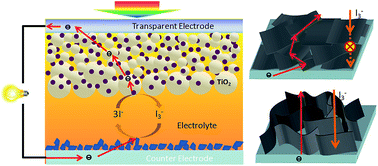Electrocatalytic properties of a vertically oriented graphene film and its application as a catalytic counter electrode for dye-sensitized solar cells†
Abstract
Vertically oriented graphene (VOG), with graphene sheets perpendicular to the substrate, exhibits meritorious electrocatalytic properties due to the fully exposed graphene (or graphitic) edges and other plasma introduced defects, even without any heteroatom functionalization. We report the growth and electrocatalytic properties of VOG by plasma-enhanced chemical vapor deposition using methane and nitrogen as source gases. Nitrogen was adopted as plasma ancillary gas to obtain a higher plasma temperature that promotes VOG growth with better electrocatalytic performance, as comparative studies demonstrated. Electron transfer dynamics measurement using a Fe(CN)63−/4− redox couple found reduction and oxidation peak-to-peak separation as low as 70 mV, indicating rapid electron-transfer kinetics. The electrocatalytic activity of the VOG electrode on an I−/I3− redox couple was found approaching that of platinum. Using VOG as the counter electrode for dye-sensitized solar cells (DSSCs), a promising power conversion efficiency of 7.63% was demonstrated. Electrochemical impedance spectroscopic study further discloses the impact of VOG properties on DSSC performance.


 Please wait while we load your content...
Please wait while we load your content...